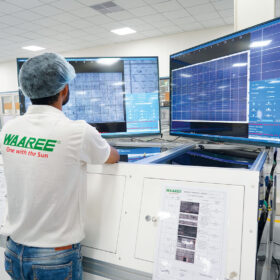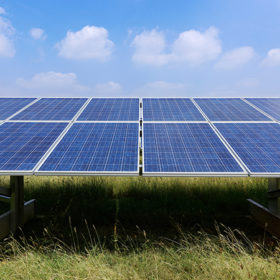pv magazine: What is the projected job creation in India’s renewable energy sector in the coming years?
India has made an extraordinary leap in its clean energy journey by achieving an exceptional milestone: 50% of the nation’s installed electricity capacity now comes from non-fossil fuel sources. This achievement, which surpasses the country’s 2030 Paris Agreement commitment by five years, is a clear indication of India’s commitment to a greener, more sustainable future. It marks a transformative shift in the nation’s energy landscape, which will also influence the global shift towards renewable energy.
India’s renewable energy sector is expected to remain a powerhouse of employment creation. A recent analysis projects that by 2030, the sector will generate over 3 million jobs in India, with 1.7 million new opportunities emerging in just the next three years.
Furthermore, direct job growth projections suggest that by 2027, the renewables industry alone could create 5–6 lakh direct jobs across solar, wind, storage, and associated value chains.
These estimates reflect both direct roles (engineering, O&M, project execution) and indirect ones (supply chain, component manufacturing, logistics). Scaling up to India’s target of 500 GW non-fossil capacity by 2030 will be a significant structural driver pushing this workforce mobilisation.
What is the current workforce size in India’s renewable energy industry?
India crossed 50% non-fossil power capacity (484 GW total) by June 2025, with solar capacity reaching 119 GW. Globally, renewable energy jobs stand at 16.2 million, with India emerging as a major hub, as per TeamLease EOR H2FY26. As of June 2025, India’s total installed power capacity has reached an impressive 484.8 GW, with 242.8 GW (50.1%) coming from non-fossil sources. These include solar, wind, hydroelectric power (both small and large), biogas, and nuclear energy.
Hydropower contributes the largest share (over 450,000 jobs), with solar and wind also driving significant employment as installed capacity surges. The sector continues to grow fast, with job creation projected to accelerate as India pursues its 500 GW clean energy target by 2030.
What are the key workforce gaps in the renewable energy sector, and what strategies can help bridge them?
Despite strong hiring momentum, the renewable energy sector faces critical workforce gaps. These include shortages in technical and operational roles such as solar PV technicians, site engineers, storage operators, and system integrators, as well as in digital and analytics functions required to support modern renewable operations. Geographic imbalances also persist. States like Rajasthan, Gujarat, Karnataka, and Tamil Nadu lead in project activity but face uneven talent availability in Tier-2 and Tier-3 areas.
To bridge these gaps, companies need to expand vocational skilling and apprenticeship programs, leverage on-the-job upskilling models, and develop localised training hubs near project clusters. Improved retention programs, structured career paths, and better welfare measures are essential to reduce churn. Staffing firms can also play a pivotal role by providing flexible deployment models and pre-trained talent pools for rapid project ramp-ups.
What are the typical entry-level and mid-level salary ranges in the renewable energy industry?
Based on industry benchmarks, entry-level technical staff such as PV technicians and site operators typically earn between INR 2.5–3.0 lakh per annum, while entry-level engineers and supervisors earn between INR 3.5–5.0 lakh per annum, depending on project location and employer scale. Mid-level professionals in operations or engineering management can earn INR 6–10 lakh per annum, with pay growth driven by experience, certification, and exposure to digital energy systems.
What is the attrition rate in the renewable energy sector, and what factors contribute to it?
Attrition remains a key structural challenge in the renewable energy labour market, with 30-40% annually. A large proportion of the workforce, especially among contractual staff, remains short-tenured, reflecting the project-based and seasonal nature of employment. The main contributors to attrition are mobility across projects, wage competition from adjacent sectors, and limited career visibility. To counter this, companies are increasingly exploring retention bonuses, safety and welfare improvements, and transition pathways from contractual to permanent roles.
What are the essential skills required for jobs in the renewable energy sector, and what is the estimated cost of upskilling employees or trainees?
The renewable energy industry increasingly demands a mix of technical, digital, and project management skills. High-demand roles include solar PV installation and maintenance, storage system operation, equipment handling, safety compliance, and automation support. As digital transformation accelerates, demand is also rising for data analytics, remote monitoring, and energy trading capabilities.
Industry benchmarks indicate that short-term certification programs for technicians (2–6 weeks) typically cost between INR 8,000–INR 30,000 per trainee, while advanced technical or digital programs can range from INR 30,000–INR 1,00,000 depending on infrastructure and certification level.
Are there any other key workforce trends or insights shaping the renewable energy industry?
Policies such as the National Green Hydrogen Mission, Solar PLI, and PM-KUSUM schemes are further expanding demand for skilled manpower. Additionally, staffing and skilling firms are increasingly integrated into project ecosystems, bridging the demand-supply gap with compliant, tech-enabled, and trained talent.
One of the strongest trends, as highlighted by TeamLease H2FY26 Employment Outlook Report ,is the sustained +4.0% hiring intent across Power & Energy, reflecting India’s record 241 GW peak demand and renewable expansion. Workforce needs are evolving rapidly from thermal and field operations toward smart grid, automation, and clean energy roles. As a result, India’s renewable energy industry is emerging not just as a sustainability driver but as one of the most dynamic job creators within the country’s formal and contractual employment landscape.
This content is protected by copyright and may not be reused. If you want to cooperate with us and would like to reuse some of our content, please contact: editors@pv-magazine.com.









By submitting this form you agree to pv magazine using your data for the purposes of publishing your comment.
Your personal data will only be disclosed or otherwise transmitted to third parties for the purposes of spam filtering or if this is necessary for technical maintenance of the website. Any other transfer to third parties will not take place unless this is justified on the basis of applicable data protection regulations or if pv magazine is legally obliged to do so.
You may revoke this consent at any time with effect for the future, in which case your personal data will be deleted immediately. Otherwise, your data will be deleted if pv magazine has processed your request or the purpose of data storage is fulfilled.
Further information on data privacy can be found in our Data Protection Policy.